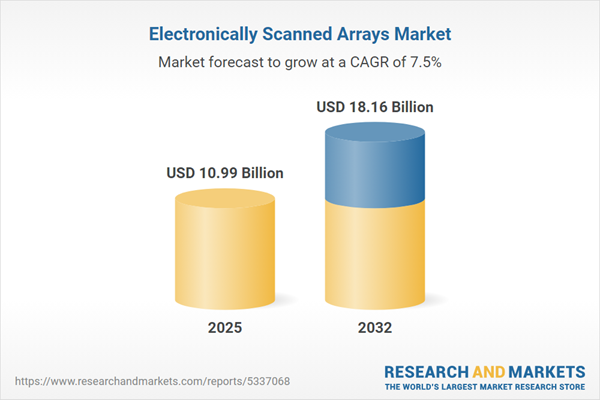Speak directly to the analyst to clarify any post sales queries you may have.
Senior decision-makers navigating the evolving landscape of communications and defense infrastructure face rising reliance on the electronically scanned arrays market. As organizations seek optimal agility and robust operational performance, best-in-class electronically scanned arrays now underpin secure connections and resilient infrastructure across mission-critical sectors.
Market Snapshot: Electronically Scanned Arrays Market Outlook
The electronically scanned arrays market continues to demonstrate resilient growth, driven by increased adoption in defense and commercial communications. In 2024, the global sector achieved a valuation of USD 10.22 billion, with projection to reach USD 10.99 billion by 2025 and a forecasted compound annual growth rate of 7.45%. The market is expected to climb to USD 18.16 billion by 2032. This expansion is being shaped by heightened defense spending, expanded deployment in secure commercial networks, and accelerated modernization across high-impact industries. Participants focus on rapid innovation, regulatory compliance, and adaptable procurement to stay ahead of changing market dynamics. Emphasis is placed on planning flexibility and responsive strategies that effectively address shifting regulatory environments and emerging operational requirements.
Scope & Segmentation in the Electronically Scanned Arrays Market
This executive summary outlines strategic segmentation to support C-level planning and efficient resource allocation within the electronically scanned arrays market. Segment-specific focus ensures alignment with evolving operational imperatives:
- Application Areas: Radar platforms, electronic warfare, navigation, and communications systems are integral to both defense and commercial advancement, reinforcing reliability and interoperability objectives.
- Platform Types: Airborne, naval, ground-based, and space-based deployments present distinctive integration requirements and regulatory landscapes, requiring tailored approaches to market penetration and implementation.
- End Use Profiles: Defense, commercial, and industrial clients possess unique procurement cycles and risk frameworks, shaping collaboration models and supplier engagement.
- Product Variants: Active and passive arrays enable mission-specific customization and compliance with performance demands in diverse operational contexts.
- Frequency Bands: C, Ka, Ku, and X bands extend the reach of intelligence, surveillance, and communications, supporting dynamic and multi-domain solutions.
- Technology Architectures: Analog, digital, and hybrid systems serve scalable upgrade paths, lower integration barriers, and support seamless interoperability.
- Sales Channels: OEMs, direct industry channels, authorized partners, and aftermarket services expand customer accessibility and reinforce lifecycle support.
- Geographic Regions: Americas, Europe, Middle East & Africa, and Asia-Pacific each face varied regulatory requirements and adoption timelines; these factors influence procurement and customization strategies for global organizations.
- Industry Leaders: Raytheon Technologies, Northrop Grumman, Thales S.A., Leonardo S.p.A., BAE Systems, Saab AB, Hensoldt AG, Rohde & Schwarz, Israel Aerospace Industries, and Mitsubishi Electric set standards in technology and best practices across the industry.
Key Takeaways: Strategic Insights for Senior Decision-Makers
- Adopting advanced electronically scanned arrays equips organizations with greater readiness and agility, supporting fast adaptation in a changing regulatory and operational environment.
- Integrating AI, machine learning, and advanced signal processing enhances responsiveness and enables improved decision-making across platforms.
- Moving toward standardized architectures streamlines system deployment and regulatory alignment, minimizing barriers to platform integration.
- Scalable, modular system designs lower maintenance costs and simplify the upgrade process, reinforcing long-term communications infrastructure sustainability.
- Collaborative efforts between established aerospace firms and emerging entrants drive technology integration, particularly in satellite-enabled initiatives within enterprise and defense enterprises.
- Digital procurement strategies offer enhanced risk management and deliver visibility into evolving project requirements and supplier performance.
Tariff Impact on Supply Chain & Competitiveness
Recent U.S. tariffs on radio frequency components and semiconductors have led organizations to adjust supply chain strategies. Companies are placing greater emphasis on domestic production, supplier compliance, and vertical integration to buffer against trade fluctuations. Through process restructuring, firms aim for quicker production, improved regulatory alignment, and added resilience—ultimately improving reliability and competitiveness in a shifting trade landscape.
Methodology & Data Sources
This research integrates executive interviews, expert panels, and sector-wide surveys. Additional analysis uses current market studies and regulatory updates to ensure precise, actionable findings for executive and procurement leaders responsible for technology risk and investment.
Why This Report Matters
- Arms decision-makers with deep insights on digital communication trends and regulatory adaptation in the electronically scanned arrays market.
- Guides targeted investment and technology adoption strategies for effective supplier selection and procurement in pivotal segments.
- Supports organizations in building preparedness and refining operational strategy for communications and electronics infrastructure expansion.
Conclusion
This analysis empowers senior decision-makers with actionable market intelligence for risk mitigation, investment steering, and informed technology adoption as electronically scanned arrays play an increasingly vital role in robust communications infrastructure.
Additional Product Information:
- Purchase of this report includes 1 year online access with quarterly updates.
- This report can be updated on request. Please contact our Customer Experience team using the Ask a Question widget on our website.
Table of Contents
3. Executive Summary
4. Market Overview
7. Cumulative Impact of Artificial Intelligence 2025
Companies Mentioned
The companies profiled in this Electronically Scanned Arrays market report include:- Raytheon Technologies Corporation
- Northrop Grumman Corporation
- Thales S.A.
- Leonardo S.p.A
- BAE Systems plc
- Saab AB
- Hensoldt AG
- Rohde & Schwarz GmbH & Co. KG
- Israel Aerospace Industries Ltd.
- Mitsubishi Electric Corporation
Table Information
| Report Attribute | Details |
|---|---|
| No. of Pages | 181 |
| Published | October 2025 |
| Forecast Period | 2025 - 2032 |
| Estimated Market Value ( USD | $ 10.99 Billion |
| Forecasted Market Value ( USD | $ 18.16 Billion |
| Compound Annual Growth Rate | 7.4% |
| Regions Covered | Global |
| No. of Companies Mentioned | 11 |









